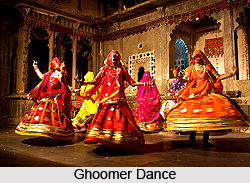 Ghoomer dance is a very famous and a community dance practiced in the Rajasthan state of India. Traditionally, the Ghoomer dance is performed only by the women. It is hugely performed on the occasion of marriage and a bride is expected to dance Ghoomer after being welcomed at her husband"s home. The dance provides an opportunity to get a cultural insight into the rich culture of Rajasthan. Ghoomer dance is also performed on various auspicious occasions like fairs and festivals in Udaipur, Jodhpur and Kota-Bundi areas.
Ghoomer dance is a very famous and a community dance practiced in the Rajasthan state of India. Traditionally, the Ghoomer dance is performed only by the women. It is hugely performed on the occasion of marriage and a bride is expected to dance Ghoomer after being welcomed at her husband"s home. The dance provides an opportunity to get a cultural insight into the rich culture of Rajasthan. Ghoomer dance is also performed on various auspicious occasions like fairs and festivals in Udaipur, Jodhpur and Kota-Bundi areas.
Etymology of Ghoomer Dance
It is called as `Ghoomer` from the `ghoomna` or pirouetting of Ghaghra i.e. the flowing of Ghaghra, a long skirt of the Rajasthani women.
History of Ghoomer Dance
Traditionally, Ghoomer dance has been developed and promoted by Bhil community in Rajasthan. This dance is considered as one of the traditional rituals among the community. It is also a community dance of the Rajputs. History says that in ancient days the royal ladies of Rajasthan used to perform this dance.
Performance of Ghoomer Dance
Women from any age group, may it be the young or old can participate in Ghoomer dance. There are simple swaying movements with special kind of footwork, to convey the spirit of any auspicious occasion. There is no limitation of time in this dance. Sometimes this dance may continue for hours or the whole night. While dancing, the dancers move in a circular direction with clockwise and anti-clockwise steps. The performers sometimes unite their hands and even clap their hand in-between. The performers move gracefully on the beat of the songs in synchronizing steps. As the tempo of the dance increases, the dancers swirl fleetly. Men and women together sing to accompany the dancers.
Costume of Ghoomer Dance
The performers of this traditional dance clad themselves in colourful ghagras that are rich in embroidery work and are also embellished with mirror-work. There is an amazing grace as the skirt flair slowly while the women folk twirl in circles, their faces covered with the help of the veil. The performers in Ghoomer dance sway their ghagras rhythmically with the beats of the music. Ornaments like colourful bangles, elegant necklaces and dazzling earrings complete the get up.



















